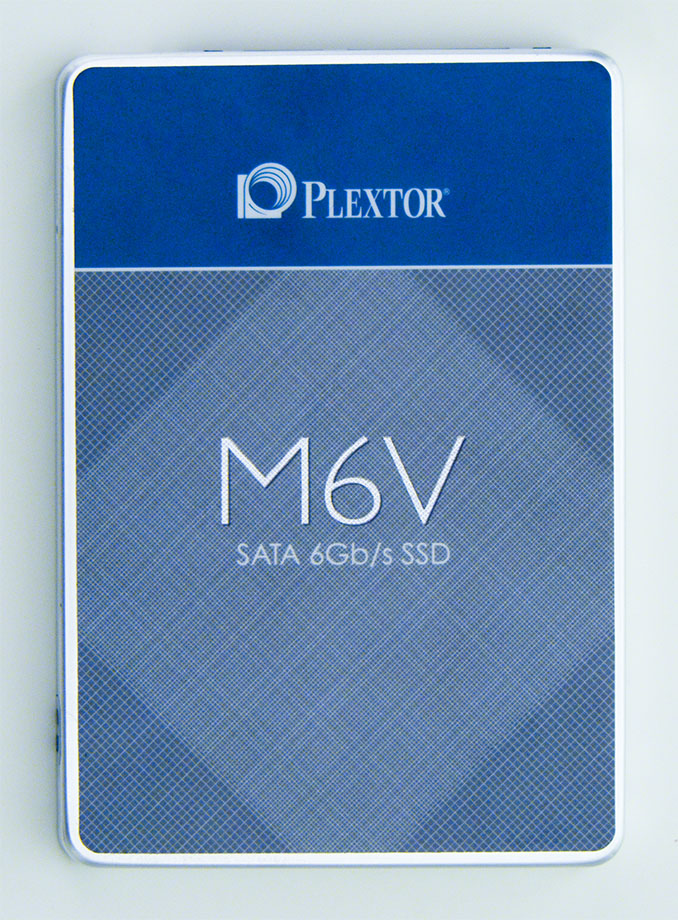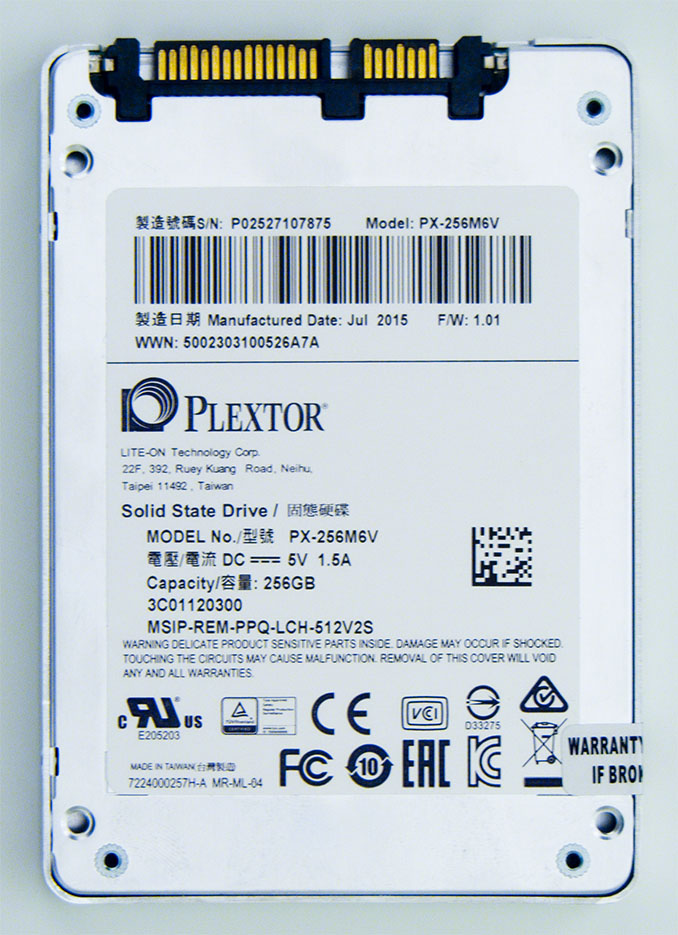The Plextor M6V (256GB) SSD Review
by Billy Tallis on October 12, 2015 8:00 AM ESTFinal Words
The value-oriented segment of the SSD market has a lot of great options at the moment for drives that don't have any critical weaknesses or major compromises relative to high-end SATA drives. This means that buying decisions will be driven almost entirely by the pricing of the moment. If priced properly, the Plextor M6V can be a great choice for general-purpose consumer use and especially for mobile use.
From a technical perspective, the most interesting aspect of the M6V is its Toshiba 15nm MLC NAND, as this is the only SM2246EN-based drive using it. Toshiba's 15nm MLC NAND seems to be a bit slower than the Micron 16nm MLC used in its closest relatives/competitors, but at the same time the M6V uses a bit less power. These differences are measurable, but probably not meaningful in the real world. The Plextor M6V and Crucial BX100 are about as close to interchangeable as drives can be without being clones that differ by only their label. The BX100's partial power loss protection may be important to some consumers but it's usually not a requirement in this market segment, and SM2246EN drives have not had any notable reliability issues.
| Amazon Price Comparison (10/12/2015) | ||||
| Drive | 120/128GB | 240/250/256GB | 500/512GB | 960GB/1TB |
| ADATA Premier SP610 | $49.99 | $84.99 | $223.44 | $379.99 |
| Transcend SSD 370 | $57.99 | $89.99 | $169.99 | $328.46 |
| Mushkin Reactor | - | - | - | $353.99 |
| Crucial BX100 | $61.99 | $79.99 | $159.99 | $314.99 |
| Plextor M6V | $65.99 | $99.99 | $189.99 | - |
| OCZ Trion 100 | $59.95 | $75.00 | $158.99 | $349.90 |
| Samsung 850 EVO | $64.00 | $89.24 | $168.63 | $343.24 |
Unfortunately, the current pricing on the Plextor M6V is simply too high in a crowded market. It's undercut by the Crucial BX100 and Samsung 850 EVO at every capacity point, and even the older SM2246EN drives using 20nm MLC are cheaper. Crucial and Samsung have the advantage of in-house NAND manufacturing, but the other competitors are just as much at the mercy of their NAND supplier as Plextor. In the long run the Toshiba 15nm MLC in the M6V ought to allow Plextor to beat ADATA and Transcend on price thanks to its greater density, but at these prices Toshiba and Plextor aren't there yet.
Ultimately if the high price is due to limited supply of the 15nm MLC, there may be significant price cuts further down the road as they get production ironed out. For now, although the M6V is as solid as any of the other SM2246EN drives, overall the BX100 remains the better value. Otherwise Plextor still has a hand to play in the market for smaller form factors; if the mSATA and M.2 variants of the M6V show up along with more reasonable pricing, they'll be very compelling for power-sensitive uses, as the BX100 is only available in the 2.5" form factor.












51 Comments
View All Comments
eddieobscurant - Monday, October 12, 2015 - link
when is the samsung 950 pro review coming up?Billy Tallis - Monday, October 12, 2015 - link
Soon.I wanted to start with a more straightforward and predictable review to make sure I had the test rig set up correctly. The 950 Pro review calls for some deeper investigation than this one, since it's the first real mainstream consumer NVMe drive and there are custom drivers and stuff like that to investigate.
coolhardware - Tuesday, October 13, 2015 - link
Sweet action, looking forward to it! :-)Coup27 - Tuesday, October 13, 2015 - link
Billy when you do the review for the 950 Pro would you be able to do a couple of paragraphs recapping over SATA Express, PCI Express, M.2, U.2 and anything else related to it? I've half kept up to date but I don't think they've done a great job of keeping it clear either.Xichekolas - Wednesday, October 14, 2015 - link
Mind having a section on Linux support/compatibility/etc in the 950 review? When you say "custom drivers and stuff like that to investigate" it makes me dread the buy-new-product-wait-a-month-for-kernel-support routine.Billy Tallis - Wednesday, October 14, 2015 - link
As I understand it, the custom drivers for NVMe is a thing everybody is doing to get around the limitations of Microsoft's driver, like not being able to send administrative commands to the drive (including the equivalent of secure erase). At least some of the features of Samsung's SSD Magician software will probably require their NVMe driver. I have yet to encounter a custom NVMe driver for Linux, only vendor-specific management tools.Anyways, the 950 Pro review's section on compatibility will be as thorough as I have time and resources for. I've done some work to equip our testbed to measure PCIe power consumption for the first time, which means I really should re-test the SM951 and XP941 for comparison's sake.
Cliff34 - Monday, October 12, 2015 - link
Thanks for the review. But it seems like these days if the SSDs cannot differentiate themselves either in price (cheaper the better), speed (faster the better) and reliability (the longer the better), there's very little incentive to buy a SSD that's somewhere in the middle.If you want value, get the BX100 (or one that's on sale) or if you want speed, get the Samsung 850 Pro or the Sandisk Extreme Pro.
zodiacfml - Monday, October 12, 2015 - link
Even Intel/Micron isn't sure if they can compete with Samsung.MagickChicken - Wednesday, October 14, 2015 - link
So am I right in thinking that this generation of consumer-grade SATA SSDs operates roughly 50% better than my current SSD, the Vertex 3?http://www.anandtech.com/show/4256/the-ocz-vertex-...
Seems like there'd be a higher increase in performance over four years considering how new the market was in 2011, though I'm certainly not going to knock the 50-60% drop in $/GB. Or is there a more significant change in the benchmarks that I'm not picking up on?
Billy Tallis - Sunday, October 18, 2015 - link
Some of the benchmark metrics are simply hitting SATA limits on bandwidth and latency. Others are constrained by the limited parallelism of interactive I/O, so the fundamental performance limits of NAND flash are showing through.Also keep in mind that pretty much all NAND production advances have been used to drive down cost, not to improve performance or reliability. We could be making SLC that's cheaper than the MLC used in early SATA SSDs, but the market prefers increased capacity and that's why we have TLC drives now and complicated slow error correction methods to keep them mostly working.